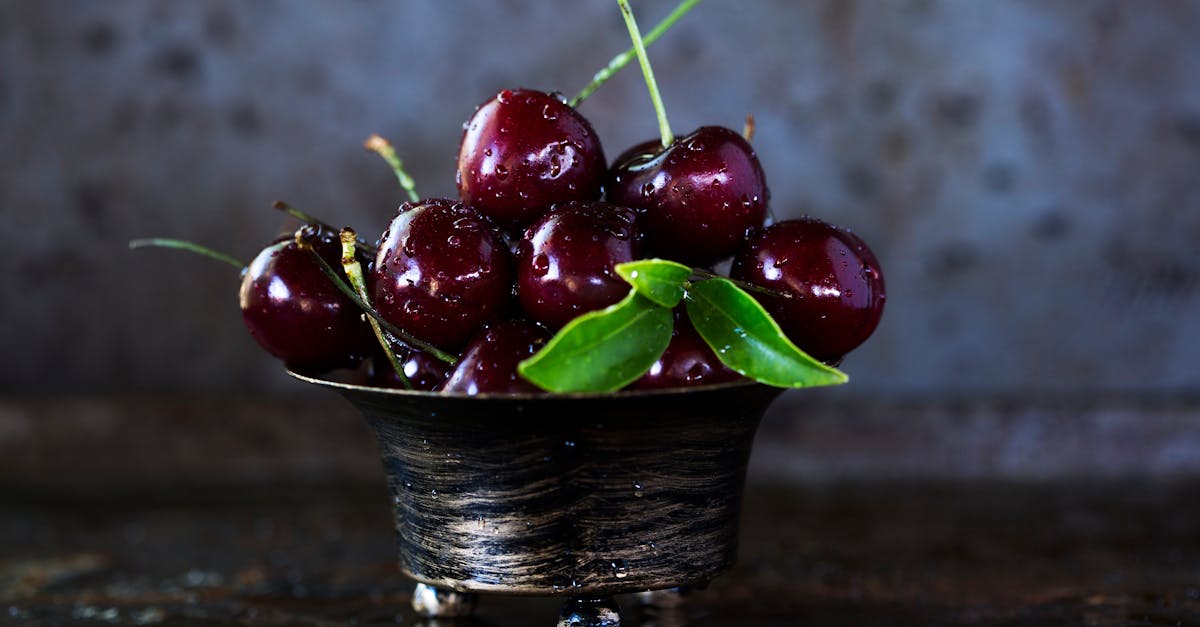Originally posted on February 28, 2025 @ 9:21 am
As summer rolls around, fresh cherries make their grand entrance at local markets, tempting us with their vibrant color and sweet flavor. There’s something special about biting into a juicy cherry that instantly transports us to sunny days and carefree moments. But as we savor these delightful fruits, we can’t help but wonder: how much are fresh cherries per pound?
Overview Of Fresh Cherry Pricing
Fresh cherries bring vibrant color and sweetness to our summer markets, but their price per pound can vary significantly. We’ll explore the factors influencing cherry prices and their seasonal availability.
Factors Influencing Price
Numerous elements affect the pricing of fresh cherries. Understanding these factors can help us navigate costs effectively.
- Quality: Higher quality cherries, such as organic or premium varieties, command larger prices. Sourced from reputable farms, they promise richer flavor and superior freshness.
- Variety: Different cherry types, such as Bing, Rainier, and tart cherries, exhibit varying price points based on demand and rarity.
- Location: Geographic factors influence pricing. Cherries in coastal markets may be pricier than those in inland areas due to transportation costs.
- Harvest Conditions: Weather conditions impact yield and quality. A poor harvest season typically leads to increased prices due to scarce supply.
- Market Demand: Seasonal popularity escalates prices. High demand during peak cherry season results in higher costs.
| Factor | Description |
|---|---|
| Quality | Higher quality cherries cost more |
| Variety | Rare varieties increase market price |
| Location | Prices vary based on geographic location |
| Harvest Conditions | Weather affects yield and quality |
| Market Demand | Increased demand during peak season raises prices |
Seasonal Availability
Cherries are typically available from late spring through early summer, with fluctuations in pricing. During peak harvest months—June and July—prices generally drop due to abundance in supply.
In contrast, fresh cherries from late summer to early fall often see increased prices as availability diminishes. As noted by cherry growers, “The best time to buy cherries at a great price is during their peak season.”
| Month | Price Range (per pound) |
|---|---|
| May | $2.99 – $4.99 |
| June | $2.49 – $3.49 |
| July | $2.99 – $5.99 |
| August | $4.99 – $6.99 |
| September | $3.99 – $5.99 |
We encourage everyone to check local markets and farms for the best deals. By understanding pricing factors and seasonal trends, we can make informed buying decisions.
Comparing Prices By Region
Fresh cherry prices vary significantly across different regions. Understanding these price fluctuations helps us make informed choices. Let’s explore the typical costs in two major areas: the East Coast and the West Coast.
East Coast Prices
On the East Coast, fresh cherry prices generally range from $3.50 to $6.00 per pound during peak season. Factors like regional supply, harvest conditions, and local market demand influence these prices. For example:
| Location | Price per Pound | Notes |
|---|---|---|
| New York | $4.50 | Organic cherries may cost more |
| Washington, D.C. | $5.00 | Prices rise during peak weekends |
| Boston | $5.50 | Specialty farms offer higher-quality cherries |
Many consumers say, “I love supporting local orchards because the cherries taste fresher!”
West Coast Prices
The West Coast tends to have lower prices, especially in cherry-producing states like California and Washington. Prices typically range from $2.50 to $5.00 per pound. Local harvest timings and export activity impact the pricing here. For instance:
| Location | Price per Pound | Notes |
|---|---|---|
| San Francisco | $3.00 | Farmers’ markets often feature cheaper options |
| Seattle | $4.00 | Organic and heirloom varieties available |
| Los Angeles | $2.75 | Prices often drop post-harvest |
A local farmer remarked, “Harvesting cherries ourselves is a great way to enjoy them fresh and save on costs.”
By comparing prices across regions, we gain insight into the best time and place to purchase fresh cherries, maximizing our budget while enjoying these seasonal delights.
Quality Considerations
When purchasing fresh cherries, quality significantly impacts price and enjoyment. Understanding the differences in cherry types and cultivation methods can help us make informed choices.
Organic Vs. Conventional
Organic cherries tend to command higher prices compared to conventional options. This pricing reflects farming practices that avoid synthetic pesticides and fertilizers. According to the USDA, organic cherries can be approximately 20% to 30% more expensive. The benefits of organic cherries include:
- Fewer chemicals: Organic farming minimizes our exposure to harmful substances.
- Better flavor: Many consumers prefer the taste of organic cherries.
- Environmental impact: Organic farming often promotes healthier soil and biodiversity.
In terms of pricing, here’s a quick comparison:
| Type | Price Range (per pound) |
|---|---|
| Organic | $4.50 – $8.00 |
| Conventional | $2.50 – $5.00 |
“Organic isn’t just a label; it represents a commitment to sustainability and quality,” says a local farmer.
Different Varieties
Cherries come in various varieties, each offering unique flavors and textures. Therefore, understanding these options can significantly influence our purchasing decisions. Some common varieties include:
- Bing: Known for their deep red color and sweet flavor, Bing cherries typically price between $3.50 and $6.00 per pound.
- Rainier: With a yellow-red hue, Rainier cherries are sweeter and can range from $4.00 to $7.00 per pound.
- Tart (Sour): Commonly used for baking and preserves, tart cherries range from $2.50 to $5.00 per pound.
| Variety | Price Range (per pound) |
|---|---|
| Bing | $3.50 – $6.00 |
| Rainier | $4.00 – $7.00 |
| Tart (Sour) | $2.50 – $5.00 |
Different varieties might be available at varying times during the season, impacting pricing and quantity. Hence, knowing what’s in season can enhance our cherry-buying experience, ensuring we select the best fruit at the right time.
By weighing factors like organic versus conventional and familiarizing ourselves with different varieties, we can maximize our satisfaction and budget when enjoying fresh cherries.
Retailers And Purchasing Options
Fresh cherries are available through various retailers, providing options for every preference and budget. Understanding these options can enhance our cherry-buying experience.
Supermarkets
Supermarkets offer a wide selection of cherries year-round. Prices often range from $3.50 to $6.00 per pound, depending on the store and region. Many supermarkets carry several cherry varieties, including:
- Bing Cherries: Known for their sweetness, prices typically range from $4.00 to $5.50 per pound.
- Rainier Cherries: These cherries are lighter in color and slightly more expensive, generally priced around $5.00 to $6.00 per pound.
- Tart (Sour) Cherries: Often used for baking, prices usually hover around $3.50 to $4.50 per pound.
Supermarkets frequently offer discounts and promotional sales, especially during peak harvest months. As one shopper put it, “I love stocking up on cherries during the summer sales; they make for delicious desserts!”
Farmers Markets
Farmers markets provide an excellent alternative for purchasing fresh cherries directly from growers. Prices here often range from $2.50 to $5.00 per pound, depending on the quality and variety. Key benefits of shopping at farmers markets include:
- Freshness: Cherries are often picked the same day, ensuring peak flavor.
- Variety: Local farmers may offer unique, seasonal varieties that supermarkets don’t carry.
- Sustainability: Supporting local farms promotes sustainable agricultural practices.
| Cherry Variety | Price Range (per lb) | Freshness Level |
|---|---|---|
| Bing | $4.00 – $5.50 | Very Fresh |
| Rainier | $5.00 – $6.00 | Very Fresh |
| Tart (Sour) | $3.50 – $4.50 | Very Fresh |
| Specialty Varieties | $2.50 – $5.00 | Extremely Fresh |
Buying local often allows us to sample cherries and engage with farmers. Quotes from vendors like, “You can’t beat the taste of fresh, local cherries,” highlight the value of choosing farmers markets.
Engaging with local vendors enhances our purchasing experience, allowing us to learn more about the growing practices and unique varieties available.
Conclusion
Fresh cherries bring a burst of joy to our summer days and knowing their price can help us savor them even more. By keeping an eye on the seasonal trends and regional differences, we can find the best deals to enjoy these delightful fruits. Whether we choose to shop at supermarkets or explore local farmers markets, the experience of picking the perfect cherries is always rewarding.
Let’s make the most of cherry season and treat ourselves to this sweet seasonal treat while supporting local growers. Happy cherry picking!


